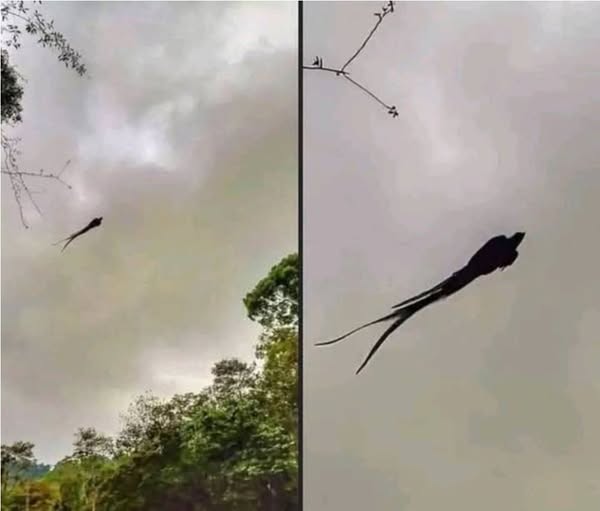In today’s digital world, a single image can spread across the internet in a matter of hours, sparking conversations, debates, and even fears that quickly ripple through online communities. Recently, one such photograph has captured global attention, making many people stop mid-scroll and ask: What exactly am I looking at?
The image in question shows what appears to be a strange creature perched quietly on a tree branch. At first glance, it looks almost otherworldly — with long, flowing feathers, a striking stare, and an aura that seems more supernatural than natural. It is no surprise that social media users from different parts of the world rushed to comment, share, and speculate. Some thought it might be an unknown species, while others worried it could be evidence of something unnatural or even frightening.
But as is often the case with viral mysteries, the truth is far less alarming and far more fascinating. This so-called “mysterious creature” is not a monster or a threat of any kind. It is, in fact, one of the most breathtaking birds on Earth: the resplendent quetzal.
The Bird That Sparked Global Curiosity
The quetzal is a rare and beautiful bird found in the cloud forests of Central America. Its feathers shine with iridescent shades of green, blue, and red, and its long tail plumes give it an almost magical appearance. To those unfamiliar with it, especially when seen in dramatic lighting or unusual angles, the bird can look like something out of a fantasy novel.
This is precisely why the photograph went viral. Taken in dim light, the bird’s feathers cast shadows that made its body shape appear unusual. To the untrained eye, it looked like a mythical creature. In reality, though, it was nature’s beauty at work — simply a quetzal sitting calmly on a branch.
A Quick Dive Into Social Media Reactions
As soon as the photo surfaced, online communities buzzed with speculation. On platforms like Facebook, X (formerly Twitter), and TikTok, comments ranged from playful jokes to genuine alarm. Some users wrote things like, “That looks like a forest spirit,” while others admitted they initially thought it was something dangerous.
Hashtags such as #MysteriousBird, #StrangeCreature, and #ViralPhoto trended in different regions. The photo even sparked memes, with some comparing the bird to characters from popular fantasy films.
Interestingly, the incident highlights how quickly misinformation or confusion can spread online. A single out-of-context photo can be enough to cause panic, even if the subject is harmless. Fortunately, experts and nature enthusiasts were quick to step in, providing explanations and reminding people of the wonders of wildlife photography.
What Makes the Quetzal So Unique?
To understand why the quetzal’s photograph caused such a stir, it helps to know more about the bird itself. Scientifically known as Pharomachrus mocinno, the resplendent quetzal belongs to the trogon family. It thrives in tropical forests, particularly in countries like Guatemala, Costa Rica, Honduras, and southern Mexico.
Some of its most fascinating features include:
- Brilliant Plumage: Its feathers shimmer in shades of emerald green, turquoise, and crimson. The colors appear to change depending on the angle of sunlight, giving the bird a surreal glow.
- Long Tail Feathers: Male quetzals grow spectacular tail plumes that can be more than twice the length of their bodies. In certain lighting, these feathers appear ghostly or translucent, which likely explains why the viral photo seemed so unusual.
- Rare Sightings: Despite its beauty, spotting a quetzal in the wild is challenging. These birds prefer high-altitude cloud forests and are known to be elusive, often hiding within dense foliage.
A Sacred Bird in Ancient Cultures
Long before the quetzal became a social media sensation, it held deep spiritual and cultural significance. For the ancient Maya and Aztec civilizations, the bird was seen as a sacred messenger of the gods. Its feathers symbolized freedom, wealth, and divinity.
- Mayan Beliefs: The Maya believed killing a quetzal would bring misfortune. Instead, they carefully plucked the bird’s tail feathers and released it back into the wild, ensuring the species remained unharmed.
- Aztec Symbolism: Among the Aztecs, the quetzal was associated with Quetzalcoatl, the feathered serpent deity. Wearing quetzal feathers was a privilege reserved for royalty and warriors of high rank.
- Modern Legacy: Today, the quetzal remains a national symbol of Guatemala. The country even named its currency, the quetzal, after the bird. This speaks to its enduring importance and respect across generations.
Why the Photo Looked So Strange
If the quetzal is such a well-known bird in Central America, why did this particular photo confuse so many people online? The answer lies in how images can sometimes distort reality.
- Lighting Conditions: Photographed in low light, the quetzal’s glossy feathers reflected shadows and highlights in unusual ways, creating an eerie effect.
- Angle and Perspective: From a direct angle, the bird’s long tail plumes and chest feathers can obscure its natural outline, making its body shape appear unfamiliar.
- Lack of Context: The photo circulated without a caption or explanation, leaving viewers to interpret it however they wished. Without context, imagination often fills the gaps.
The Power of Viral Mysteries
This incident is just one example of how quickly curiosity can spiral on the internet. From supposed UFO sightings to blurry animal photos, humans have a long history of interpreting strange visuals in fantastical ways. The quetzal case serves as a gentle reminder that not everything mysterious is threatening. Sometimes, the answer is simply the beauty of the natural world.
Interestingly, viral mysteries like this often have a positive outcome. In this case, many people who had never heard of the quetzal before learned about its existence and its cultural importance. Wildlife experts reported a surge of interest in conservation efforts and tourism focused on birdwatching in Central America.
The Importance of Protecting the Quetzal
While the viral photo brought laughs and curiosity, it also shines a spotlight on an important issue: conservation. The quetzal is considered near-threatened due to habitat loss, deforestation, and climate change. Its cloud forest environment is fragile, and human activity has reduced the bird’s natural habitat.
Conservation organizations in countries like Costa Rica and Guatemala work tirelessly to protect the quetzal. Eco-tourism, which allows visitors to observe these birds in their natural habitat, has become a significant way to fund these efforts. For many, seeing a quetzal in person is a once-in-a-lifetime experience.
Lessons From the Viral Photograph
The story of the mysterious quetzal photo offers several broader lessons:
- Not Everything Strange Is Dangerous – Sometimes, what looks frightening is actually something beautiful we don’t yet understand.
- Context Matters – A photograph without background information can easily mislead people. Providing explanations helps prevent misinformation.
- Social Media Can Educate – While confusion spread quickly, so did knowledge. Many users walked away knowing more about a species they had never encountered before.
- Conservation Awareness – Viral moments like these can be leveraged to encourage wildlife protection and appreciation for biodiversity.
Final Thoughts
At first glance, the viral photo of the quetzal may have looked like something mysterious or even supernatural. But in reality, it revealed something far more valuable: the ability of nature to inspire awe and wonder, even in a world saturated with digital content.
The next time a strange image appears online, it may be worth pausing before jumping to conclusions. As this case shows, the explanation is often not only harmless but also deeply enriching. The quetzal, once mistaken for something strange, is a reminder that the natural world still holds endless surprises waiting to be discovered.
In the end, the story isn’t about a “creature” causing fear. It’s about a bird that has captivated civilizations for centuries and continues to inspire wonder in the modern age — whether in the cloud forests of Central America or on the screens of millions around the world.




